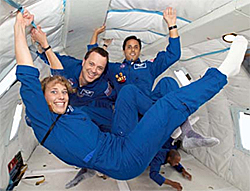 Planets, stars and moons are not the only occupants of the universe. Our solar system alone is filled with amazing things and phenomena that are sometimes difficult to explain. Microgravity is one phenomena.
Planets, stars and moons are not the only occupants of the universe. Our solar system alone is filled with amazing things and phenomena that are sometimes difficult to explain. Microgravity is one phenomena.
Learning in school, we learn that gravity is an invisible force between objects as the Earth tries to pull everything down towards the center. It’s what allows us walk on the surface (as it pulls us back to the ground) and is synonymous with the saying “what goes up must come down.”
Microgravity, on the other hand, is the absence or lack of gravity. It is also known as weightlessness and enables astronauts in space to float around. People on Earth experience it too – while riding an airplane or when an elevator suddenly drops a few floors below. Other free-fall activities such as jumping off diving boards or riding a rollercoaster enable people to experience microgravity. Or simply put, flipping a coin in the air – it is that time in between (the second you toss it up until the second it hits the ground) that you have just subjected it to microgravity.
Experiments in microgravity are now being done as it has shown great promise in the development of new things – medicine and drugs that can be beneficial to people who need treatment, cell-growth processes and the possibility of creating new machinery for industrial development.
